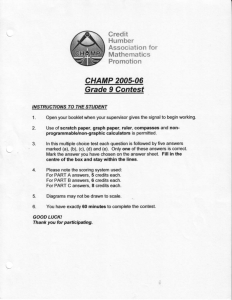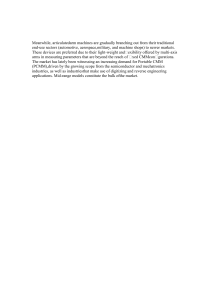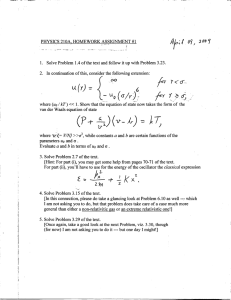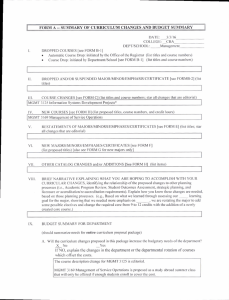Declassified Army Study: Microwave Bioeffects & Nonlethal Weapons
advertisement
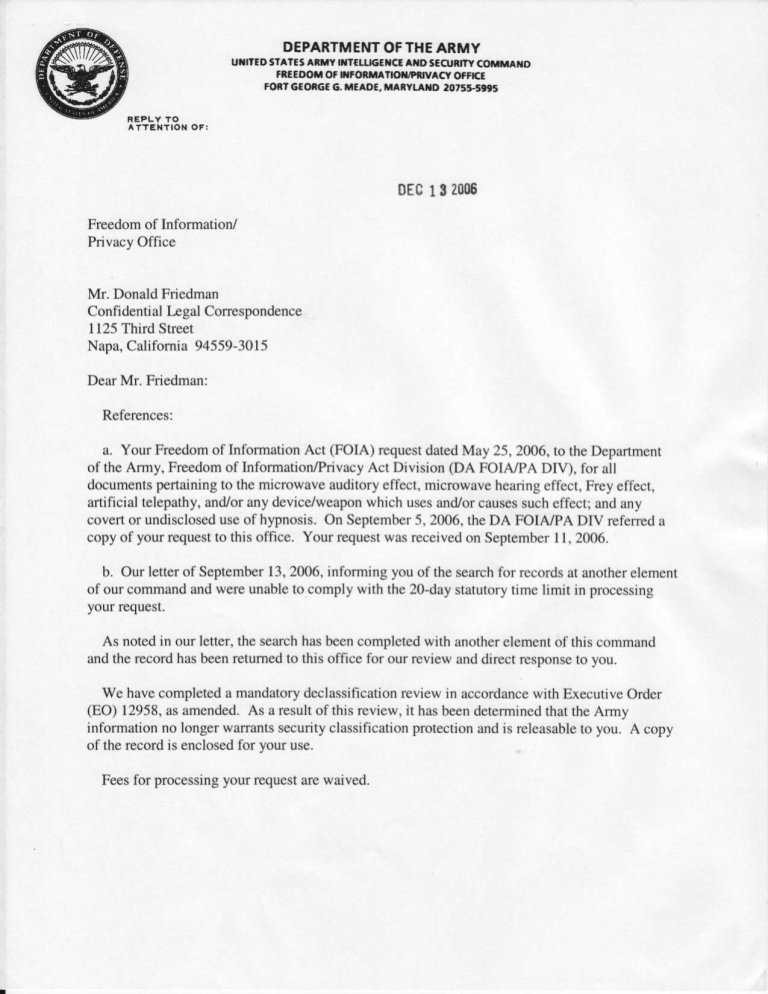
DEPARTMENT
OFTHE
ARMY
uxtllD tlAltS Affy laTttucl|lct Af,o ffqjtny coina
ttDof ot trFoRxrlox/Fiw CaofftcE
foircloic!
G.Maao€,[aivtaxo ao75t5t95
o
DE818 2000
Freedomof Infomation/
PrivacyOffice
Nft,DonaldFriedman
ConfidentialLegal Correspondence
ll25 Thid Steet
Napa,Califomia 94559-3015
DearMr. Friedman:
References:
a. Your Freedomof InformationAct (FOIA)requestdatedMay 25,2006,to theDepartment
ofthe Afmy, Freedomof Information/Privacy
Act Division(DA FOIA/PADIV), for all
pertainingto themicrowaveauditoryeffect,microwavehearingeffecr,Freyeffect,
documents
artificialtelepathy,
and/oranydevice/weapon
whichusesand./or
causessucheffect;andany
covertor undisclosed
useof hlpnosis. On September
5, 2006,theDA FOIA/PADIV refeneda
copyof yourrcquestto thisoffica. Yow requestwasreceivedon September
11,2006.
b. Our letterof September
13,2006,infoming youof thesearchfor recordsat anotherelement
ofour commandandwereunableto complywith the20-daystatutorytime limit in processrng
yourrequest.
As notedin our letter,the searchhasbeencompletedwith anotherelementof thiscommand
andtherecordhasbe€nretumedto this officefor our reviewanddirectresponse
to you.
We havecompleted
a mandatory
declassification
reviewin accordance
with ExecutiveOrder
(EO) 12958,asamended.As a resultofthis review,ithas beendetermined
thattheArmy
protectionandis releasable
informationno longerwarrantssecurityclassification
to you. A copy
for youruse.
ofthe recordis enclosed
yourrcquestarewaived.
Feesfor processing
concemingthis action,pleasefeelfreeto contactthis officeat (301)
If youhaveanyquestions
677-2308.Referto case#614F-06.
Sincercly,
*-a,JL"J
tterfreld
Freedomof Information/PrivacyOffice
InvestigativeRecordsRepository
Enclosure
SEEffif
iieFenAr
Bioeffectsof SelectedNonlethal
Weapons(fn1)
(NGIC-I 147-101-98)
This addendum
to theNonlethalTechnologies*Worldwide
study
addresses
in summary,someofthe mostoftenaskedquestions
ofnonlethalweapons
theph)siologicalresponses
observedin clinicalsettingsofthe biophysical
technology,
couplingandsusceptibility
ofpersonnelto nonlethaleffectsweapons.
Theseresults
of maturingnonlethaltechnologies
identifyandvalidatesomeaspects
thatmaylikely be
encounteredor usedasnonlethaleffectorsin the future includins:
.
.
.
Laserandother light phenomena.
Radioftequency
directedenergy.
Awal bioeffects.
fieldsandtheirinfluenceon biologicalsystemsis
Thestudyofelectromagnetic
incraaiingrapidly.Much ofthis wo* is takingplacebecause
ofhealthconcems.
For
concemhasarisenregardingtheeffectsofoperatorexposure
example,increased
to the
with short-wave
electromagnetic
fieldsassociated
diathermydevices,high power
magneticresonance
microwaveovens,rada!systems,
imagingunits,etc.In addition,
(60 Hz powerfrequency)
muchconcemhasarisenaboutextremelylow frequency
eleakicandmagneticfieldsthatoriginatefiom high-voltage
kansmission
lines,indust[ial
equipment,
andresidential
appliances.
Both occupational
andresidentiallo[g-term
exposure
havebeenthe focusofepidemiological
studies.Thestudieshavesuggested
possibleadverse
effectson humanhealth(e.9.,cancer,rcproduction,
etc.).Laboratory
is still beingpursuedto identifypossiblemechanisms
research
ofinteraction.However,
otherthanthermalheatingfor microwavefrequencies,thereis no yet agreed-upon
mechanism
ofaction.As a co[sequence,
our knowledgebaseis developed
entirelywith
phenomenological
Because
observations.
ofthis fact,it is not possibleto predicthow
norithermalbiological effectsmay diflbr llom one exposuremodality to another.It is
ofthe smalldatabasefor fastpulses,to predictbiological
especially
difficult,because
might
be
associated
with high-powerpulsesofextremely shortduration.
effectsthat
Thereis, however,a growingperception
thatmicrowaveirradiationandexposure
to low
frequency
fieldscanbe involvedin a widerangeofbiologicalinteractions.
Some
investigatorsare evenbeginningto describesimilaritiesbetweenmicrowaveirradiation
anddrugsregardingtheir effectson biological systems.For exarnple,somesuggestthat
powerdensityand specificabsorptionrate of microwaveirradiationmay be thoughtofas
analogousto the concentrationofthe injection solutionandthe dosageofdrug
EEGRADBbUNCj
AssT$EDP,.ff
c.
BY US.AINSCOMFOIAA
AUh Psra.'. t02 DOD 52eii.tR
t
respectively.
admin;stration,
Clearly,theeffectsofmicrcwaveson braintissue,
chemistry,and functionsarc complexandselective.Observationsofbody weight and
behaviorrevealedthat ruts, exposedrmdercertainconditionsto microwaves,eatand
drink less,havesmallerbodyweightasa resultofnonspecificstressmediatedtbrough
the centralnenous systemandhavedecreasedmotor activity. It hasbeerlfoundthat
exposureof the animalsto onemodality of radiofiequencyelectromagneticenergy
substantiallydecreasesaggtessivebehaviorduring exposure.However,the opposite
effectsofmicrowaves,in increasing
themobilityandaggression
ofanimals,hasalso
beenshownfor a differentexposure
modality.Recentpublisheddataimplicates
microwaves
asa factorrelatedto a deficitin spatialmemoryfunction.A similartlpe of
effectwasobserved
with exposure
to a "resonance
tuned"extremelylow frequency
magneticfield.Thus,the databaseis repletewith phenomenological
observations
of
biologicalsystems"affected"by exposure
to electromagnetic
energy.(Thefactthata
biologicalsystemresponds
to anextemalinfluencedoesnot automatically
nor easily
truslate to thesuggestion
ofadverseinfluenceon health.)Theobjectiveofthe present
studywasto identifyinformationftom this developing
understanding
ofelectomagnetic
effectson animalsystemsthatcouldbe coupledwith humanbiologicalsusceptibilities.
Situations
whcrcthc intersection
ofthesetwo domainscoexistDrovideoossibilities
for
usein nonlethalapplications.
I[capacitatingEffect: MicrowaveHeatitrg
Bodyheatingto mimic a feveris thenatuleofthe R.Fincapacitation.
Theobjectiveis to
provideheatingin a very controlledway so thatthebodyreceives
nearlyuniformheating
andno organsaredamaged.
Coretemperatwes
approximately
41oC areconsidered
to be
adequate.
At suchtemperature
a considerably
changed
demeanor
will takeplacewith the
individual.Most p€ople,underfeve!conditions,
becomemuchlessaggrcssive;
some
peoplemaybecomemoreinitable.Thesubjectivesensations
producedby thisbuildupof
heatare far more unpleasantthanthoseaccompanyingfever.In hlperthermia all the
effectorprocessesare stminedto the utrnost,whereasin feverthey axenot. It is also
possiblethatmicrowaveh,?erthermia(evenwith only a 1' C increase
in brain
temperature)may disrupt working memory,thusresultingin disorientation.
BiologicalTsrgeUNormalFunctious,/Disease
State
The temperatureof warm-blooded(homeothermic)animalslike the humanrcmans
pnctically unchangedalthoughthe surroundingtemperaturemay vary considerably.The
nomal humanbody tempentue recordedftom the mouthis usuallygiven as37' C, with
the iectal tempemtue one degreehigher.Variation betweenindividualsis tlpically
between35.8' C and37.8' C orally.Variatiorcalsooccurin anyoneindividuai
throughoutthe day-a differenceof l 0' C or even2.0oC occurringbetweenthe
maximumin the late allemoonor early evedng, andthe minimum between3 and5
o'clockin themoming.Strenuous
muscularex€rcisecausesa temporary
risein body
proportional
temperatuethat is
to the severityofthe exercise;the level may go ashigh as
40.0.c.
Extremeheatstress,suchthat the bodys capacityfor heatlossis exceeded,causesa
pathologicalincreasein the temperatureofthe body. The subjectivesensationsprcduced
by this buildup ofheat are far moreunpleasantthan thoseaccompanyingfever.In
hyperthermiaall the effectorprocessesare stained to the utmost,whereasin feversthey
arenot. The limiting temperaturefor survival,however,is the samein both cases--abody
temperatureof42o C. For briefperiods, peoplehavebeenknown to survivetemperatures
ashigh as43 ' C.
In prolongedh)?erthermia,
with temperatures
over40' C to 41. C, thebminsuffers
severedamagethat usuallyleadsto death.PeriodsofhlTrerthermiaare accompaniedby
cerebraledemathat damagenewons,andthe victim exhibitsdisorientation,delirium, and
convulsions.
This sFdromeis popularlyreferredto assunstroke,
or heatstroke,
dependingon the circumstances.
Whenthe hyperthermiais prolonged,brain damage
interfereswith the centralthermoregulatorymechanisms.In particular,sweatsecretion
ceases,so that the condition is furtherexacerbated.
Mechanismto Producethe DesiredEffects
This conceptbuildson about40 yearsofexperience
with theheatingeffectsof
microwaves.
Numerousstudieshavebeenperfomedon animalsto identify
characteristics
ofimportanceto theunderstanding
ofenergydepositionin animals.As a
resultof thephysics,the relationship
betweenthe sizeofthe animalandthewavelength
ofthe radiofrequency
energyis mostimportant.In fact,thehumanexposure
guidelines
to
radioftequencyradiationare designedaroundknowledgeofthe differential absorptionas
a functiorof fiequencyandbodysize.Thechallenge
is to minimizethetime to effect
permanent
while causingno
injury to any organor the total body andto optimize the
equipmentfunction.The orientation
ofthe incidentenergywith respectto theorientation
ofthe animal is alsoimportant.
In a studyofthe effect ofRF radiationon body tempelaturein the Rhesusmonkey,a
freqtency (225 MHz) is purposelychos€nthat depositsenergydeepwithin the body o f
the animal.A dos€rate of 10 W,&gcausedth€ body temperatureto increaseto 42oC in a
shorttime (10-15min),To avoidineversibleadverseeffects,th€exposurcwas
terminatedwhen a temperatureof 42oC wasreached.A lower doserate of 5 W,&g
causedthetemperature
to increase
to 41.5oC in lessthan2 hours.Thereversiblenarure
ofthis responsewasdemonstrated
by the rapid drcp in body temperaturewhen RF
exposurewas teminated beforea critical temperatureof42o C wasreached.It is
estimatedfor rats that the abso6edthresholdconrulsive doselies between22 a!|td35 !/g
for exposuredwationsftom lessthar a secondto l5 minutes.For 30-pinute exposurc,
the absorbedthresholddosefor decreasein enduranceis near20 J/g, the thresholdfor
work stoppageapproximately9 J/g, andthe thresholdfor work pertubation rangesliom
5 to 7 yg. All ofthe abovemeasures,
exceptconvulsions,
arct)?esofnonlethal
incapacition.
A rough estimateof the power requiredto heata humanfor this technologyis on the
orderof l0 Wkg givenabout15to 30 minutesoftargetactivation.Actualpowerlevels
dependon climatic factors,clothing, andother considerationsthat affect the heatloss
Aom the individual concemed.A methodfor expressingdoserate in termsofbody
surfacearea(i.e., wattsper squaremeter)ratherthanbody mass(i.e., wattsper kilogam)
wouldpemit a morereliablepredictionofthermaleffectsacrcssspecies.
However,there
axelargeuncertaintiesin the ability to extrapolatethermorcgulatoryeffectsin laboratory
animalsto thosein humanbeings.
This technologyis an adaptationoftechnology which hasbeenaroundfor many years.lt
is well known that microwavescanbe usedto heatobjects.Not only is microwave
technology
usedto cookfoods,but it is alsousedasa directedsourceofheatingin many
industrialapplications.
It waseventhesubjectofthe "PoundProposal',
a few yearsagoin
whichtheideawasto provideresidential
heatingto people,not living space.Because
of
the apparentlysafenatureofbody heatingusingmicrowavetechniques,a variety of
innovativeusesofEM energyfor humanapplicationsarebeing explored.The nonlethal
application
wouldembodya highlysophisticated
microwaveassembly
thatcanbe uscdto
prcjectmicrowaves
in orderto providea conholledheatingofpersons.This controlled
heatingwill raisethecoretemperature
ofthe individualsto a predetermined
levelto
mimic a highfeverwith the int€ntofgaininga psychological/capability
edgeon the
enemy,while not inflictingdeadlyforce,Theconceptofheatingis straightforward;
the
challenge
is to idgntifyandproducethecorrectmix ofliequenciesandpowerlevels
neededto do the remoteheatingwhile not injuring specificorgansin the individuals
illuminatedby the beam.
A varietyoffactorscontributeto the attractiveness
ofthis nonlethaltechrology.First,it
is basedon a well-knowneffect,heating.Everyhumanis subjectto theeffectsofheating;
therefore,
it wouldhavea predictabilityratingof 100%.The timeto onsetcanprobably
be engine€red
to betweel15and30 minutes;however,timing is thesubjectofaddilional
research
to maximizeheatingwhile minimizingadverse
effeatsof localizedheating.the
onsetcanbe slowenoughand,/or
ofsuch frequency
to be unrecogniz€d
by theperson(s)
beinginadiated.Safetyto innocents
couldbe enhanced
by theapplicationandadditional
developme[tof advancedsensortechnologies.locapacitationtime could be extendedto
almostany desiredperiod consistentwith safety.(Given suitableR&D, temperatureor
othervital signscould b€ monitorcdremotely,andtemperaturecould be maintainedat a
minimum effectivepoint).
Tim€ to Onset
Thetime to onsetis a fulction ofthe powerlevelbeingused.Carefullymonitored
uniformheatingcouldprobablytakeplacein betweenl5 and30 minutes.Timero orcet
could be reducedbut with increasedrisk of adverseeffects.Minimum time is deDendent
on the power level ofthe equipmentandthe efficiency ofthe aiming device.
Duration of Effect
Assumingthat the heatingis donecarefully, reversalof elevatedbody temperaturewould
begin as soonasthe sourceofheat is removed.
Tunability
This conceptis tunablein that anyrute ofheating, up to the maximumcapacityof the
souce, may be obtained.Thus it is suitablefor usein a gradualforce or ',rheostatic',
approach.Ifthe situationallows, andthe sourceis sufficiently powerful, thereis the
possibilityto usethistechnologyin a lethalmodeaswell. Prolonged
bodytemperature
above43' C is almostcertainto result in permanentdarnageto the brain anddeath.
Distribution ofHuman Sensitivitiesto DesiredEffects
No reasonhasbeenidentified to suggestthat anyonewould be immuneto this
technology.Individualswith compromisedthermoregulatorymechanismswould be
susceptiblewith a lower incident energydensity.This would includepeoplewith orgalnc
damageto the h,?othalamus,the part ofthe brain that integatesthe autonomic
mechanisms
whichcontrolheatlossaswell aspeoplewith compromised
somaticfeatures
ofheatloss(e.g.,respiration,
waterbalance,etc.).
Thetechnologies
neededfor thethermaltechnology
conceptarerelativelywell
d€veloped
because
ofthe knownbiophysical
mechanism,
theuniversalsusceptibility
of
humansto themechanism
ofheating,andbecause
ofa well developed
t€chnology
base
for the productionofradiofrequencyladiation. Becausethe huma.nbody is
inhomogeleous,
ceftainorgansare,by virtueoftheir sizeandgeometry,
moreeasily
coupledwith oneradiofrequency
wavelength
thananother.
Therefore,
to avoidpermanent
damageto thesusp€ctor to innocentbystarders,
it maybenecessary
to vary the
frequency
to avoidlocalizedheatingandconsequent
damageto anyorgan,Additionally,
it will be necessaryto avoid the conditionsthoughtto be associated
with the induction of
cataracts.
Thus,while thetechnologyofmicrowaveheatingin generalis matule,
adaptation
asa nonlethaltechnologywill rcquiresophisticated
biophysical
calculations
k)
proper
identifythe
regimenofmicrowavellequencies
andintensities;
it will alsobc
necessaryto optimize existinghardwareto meetthe bioph,sical requirements.
PossibleItrflu€oc€or Subject(s)
Ifthe technologyfunctionsapproximatelyasenvisioned,the targetedindividual could be
ircapacitated
within l5 to 30 minutes.Because
this technology
is focusedon a relatively
slow onset,it shouldonly be usedin situationswherespeedis not important.The very
uncomfortable
natureofa highbodytemperature
maybe usefulin negotiations
or
possiblyfor controllingcrowds.It wouldbe equallyusefulon singlepersonsot crowds.
Evidencealsoindicatesa disruptionofworking memory thusdisorientationmay occur
because
ofall inabilityto consolidate
memoryofthe recent(minutes)past.
TechnologicalStatusof Generator/AimingDevice
Equipmentneededto explorethis conceptin the laboratoryis availabletoday.Designand
constructionofthe RF/microwavegenemtorwill dependon the constraintsposedby the
calculations,potentialgenerationdevices,alld energy-directingstructures.A variety of
optlonsexistfor bothoftheseequipment
needs.Theuseof advanced
frequencyand
modulation-agile
generation
RF
andamplificationcircuitrywill be requiredto o"scss
fully the frequency/power/time
envelopeofRF heatingprofiles requir;d. Although much
equipmentis cornmerciallyavailable,it is likely that customhadware andsoftwarewill
be necessarybecauseavailableequipmenthasnot beendesignedwith the needfor
frequ€ncy/intensilyvariability, which w.ill probablybe neededfor safetypurposes.In
addition,the designof antennasandother energy-directingstructues wili almost
certainlyinvolveuniqueconfigurations.
Sincethistechnologyutilizesradiofiequency
energy,it canbe defeated
by theuseof shieldingprovidedby conductive
bariers like
metal or metal screen.
IrcapacitatingEffect: MicrowaveHearirg
Microwavehearingis a phenomenon,
descdbed
by humanobservem.
as.thesensations
of
buzzing,ticking, hissing,or knockingsoundsthat originatewithin or imrnediatelybehind
the head.Thereis no soundpropagatilg throughthe air like nomal sound.This
technology
in its crudes!form couldbe usedto distractildividuals:ifrefined. it could
alsobe usedto communicate
with hostages
or hostagetakeNdirectlyby Morsecodeor
othermessage
possibly€venby voiaecommudcation.
systems,
BiologicalTarget/NormslFunctiotrs/Disease
State
This technology
makesuseofa phenomenon
first described
in the literatureover30 vears
ago.Differentt)?esofsoundswerehearddepending
on theparticularsofthe pulse
characteristics.Vaf,iousexperimentswer€performedon humansand laboratorvanimals
exploringtheoriginofthis phenomenon.
At thistime,virtuallyall investigators
who hrve
studied_the
phelomenonnow acceptthermoelastic
expansion
ofthe brain,-the
pressurc
waveofwhich is rcceivedandprocessed
by thecochlearmicrophonicsystem,iohc tlrc
mechanism
ofacousticperception
ofshortpulsesofRF energy.Onestudy(in 1975)
usilg humanvolunteers,
identiliedthethresholdenergyofmicrowave-auditory
rcsponscs
in humansasa functionofpulsewidth for 2450MHz radioftequency
energy.it is also
foundthat about40 J/cmzincident energydensityper pulsewai required.-'
Mechanismto Producethe DesiredEffects
After the phenomenonwas discovercd,severalmechanismswere suggestedto explain the
hearingofpulsedRF fields.Thermoelastic
expansion
within thebrainin rcsponse
to RF
pulseswas flrst studiedanddemonstntedin inert matedalsfid was Droposedasthe
rnechanism
ofhearingofpulsedRF fields.A presstlre
waveis generitedin mostsolid
andliquidmaterialsby a pulseofRI energy--a
pressurc
wavethatis sevemlordersof
magnitudelarger in amplitudethanthat resultilg from radiationpressureor from
elecnoslrictive
lorces.Thecharacteristics
ofthe field-induced
coihlearmicroohoruc
rn
guinea
pigsandcats.therelationship
ofpulseduralion
phvsicri
andltu-eshold.
measurements
in waterandin tissue-simulating
materials,
aswell asnumeroustheoretical
calculations-all point to thermoelasticexpansionasthe mechanismofthe hearins
Dhenomenon.
Scientistshavedeterminedthe thresholdenergylevel for humanobserversexposedto
pulsed2450-MHzfields(0.5-to32 micrcnpulsewidths).Theyfoundthat,regardless
of
the peakofthe power densityandthe pulsewidth, the per-pulsethresholdfoia normal
subjectis neax20 mJ/kg.The avemgeelevationofbrain temperature
associated
with a
just-perceptible
pulsewasestimated
to be about5xl0 6. C.
Time to Onset
The physicalnatureofthis themoelasticexpansiondictatesthat the soundsareheardas
theindividualpulsesareabsorbed.
Thus,the effectis immediate(withinmilliseconds).
Humanshavebeenexposedto R.Fenergythat resultedin the Droductionof sounds.
Duration of Effect
Microwavehearinglastsonly aslong asthe exposure.Thereis no residualeffect afier
cessation
ofRF energy.
Turability
Th€ phenomenonis tunablein that the characteristicsoundsandintansitiesofthose
soundsdependon thecharacteristics
ofthe RF energyasdelivered.Because
the
ftequencyofthe soundheardis dep€ndent
on thepulsechamcteristics
ofthe RF energy,
it seemspossiblethatthis technology
couldbe developed
to thepointwherewordscould
be hansmittedto beheardlike the spokenwod, exceptthatit couldonly bo heardwithin
a person's
head.In oneexperiment,
communication
ofthe wordsfrom oneto ten using
modulated"
microwaveenergywassuccessfully
"speech
demonstrated.
Microphones
next
to thep€rsonexperiencing
thevoicecouldnot pick up thesound.Additionaldevelonncnt
ofthis wouldopenup a widerangeofpossibilities.
DistributiotrofHuman SeDsitlvities
to Desir€dEffects
Becausethe phenomenonactsdirectly on cochlearprccesses,the thermoelasticpressure
wavesploducesoundsofvarying Aequency.Many ofthe testsrun to evaluatgthe
phenomenonproducedsoundsin the 5 kHz rangeandhigher.Becausehumansarekno.wn
to experience
a widerangeofhearinglossdueto cochleardarnage,
it is possiblethat
somepeoplecanhearRF inducedsoundsthat otherswith high &equencyhearingloss
cannot.Thus,thereis a likely rangeofsensitivity,primarilybasedon thet)?e ofpulse
andtheconditionofthe cochlea.Bilateraldestruction
ofthe cochleahasbeen
demonstxated
to abolishall RF-inducedauditorystimuli.
RecoYery/Safety
Humanshavebeensubjectedto this phenomenonfor many years.The energydeposrnon
requiredto producethis effect is so smallthat it is not consideredhazardous
expenmentationwheninvestigatingresponsesat thejust-perceptiblelevels.
11
PossibleInfluenceon Subject(s)
Application ofthe microwavehearingtechnologycould facilitate a pdvate message
transmission.It may be usefulto provide a disruptiv€conditionto a personnot awaxeof
the technology.Not only might it be disruptiveto the senseofhearing, it could be
psychologicallydevastatingif onesuddenlyheard"voiceswithin one'shead."
TechnologicalStatusof Getrerator/AimingDevice
This technologyrequiresno extrapolationto estimateits usefulness.Microwave energy
canbe appliedat a distance,andthe appropriatetechnologycanbe adaptedftom existing
radarunits.Aiming deviceslikewise are availablebut for specialcircumstanceswhich
requireextremespecificity, theremay be a needfor additionaldevelopment.Exteme
directionalspecificitywouldbe requircdto hansmita message
to a singlehostage
by his captors.Signalscanbe transmitted
(huDdreds
sunounded
longdistances
ofmeters)
usingcurrenttechrology.Innger distances
andmoresophisticated
signaltlpes will
but it seemspossibleto transmitsomet,?e ofsignalsat
requiremorebulky equipment,
closerrangesusingman-potableequipment.
Range
Theeffectiverangecouldbe hundreds
ofmeters.
IncapacitatingEffect: Disruptionof Neural Coutrol
The natureof the incapacitationis a rhythmic-activity sFchronization of brain neurons
thatdisruptsnormalcodicalconkolofthe corticospinal
pathwaysthrs
andcorticobulbar
disruptsnormalfunctioningofthe spinalmotorneuronswhichcontrolmuscleconltlclron
andbodymovements.
Persons
sufferingfrom thisconditionlosevoluntarycontrolof
theirbody.This s),nchrcnization
maybe accompanied
by a suddenlossofconsciousness
andintensemusclespasms.
BiologicalTargeUNormalFunctions/Disease
Strte
The normal function ofthe brain is to control all forms ofbehavior, voluntary control of
body, and the homeostaticpararnete$ofthe organism.In normalconditions,all the brain
structur€s,neuro[ populations,networks,and singleunits functionwith specificrhyhnic
activity dependingon the incoming sensoryinformatioq infomation fiom mnemonic
skuctwes,andsignalsf:romvisceralorgans.Eachsingleneuronprovidesspecific
processingofinformation it receivesand forms a specificpatternofimpulse firing as
outgoinginformation.Synchronizationofn€won activity is a natual mechanismofthe
brain function that usessuchcontrolling processesasmotivation,attentionandmemory
(experience)in orderto organizebehavior.For example,motivationalprccessesare
consideredasactivatingascendingsignalsthat slarchronizethe neuronactivity ofspecific
brain structuresandneuronnetworks;this activation/slnchronizationin hrm activates
specificformsofbehaviorsuchassexual,aggressive,
ingestiveactivities.
In normalfunctioningthe degreeofneuronal synchronizationis highly controlled.From
expedmentsthat rccordthe neuronalactivity iI1different bmin axeassimultaneouslvin
animals,it is knownthatcorelationofspike activitybetweenneurons(measured
bl the
correlationlevel of synchronization)changesdependingon the slageof behavior,
motivation,attention,or activationofthe memoryprocesses.
HowJver,undersome
conditions,suchasph)rsicalstress,heatshock,or shong emotionalstress,the l€vel of
s),ncbronizationmay becomehigher,involving nonspecificlargepopulationsofbrain
neuronsandtle s)mclronizationmay becomeuncontrollable.
Dependingon at which frequencythe slmchronizationrh),thmoccursand how many
neuonsareinvolved,it mayproducedifferentphysicaleffects;muscleweakness,
involuntarymusclecontractiols,lossofconsciousness,
or intense(tonic)musclespasms.
The higherlevel of sl,nchronizationtakesplacein personsaffectedwith epilepsywhen
theyexpedence
periodicseizures
sincetheyhavea pathologicsource(e.g.,frorninjury to
the brain) of rh',thmic s)'nchronization.Becausethe neurophysiologicalrnechanismsof
epileptiformsyrchronization
arebetterdocumented,
this incapacititingtechnologyrs
described
in termsof €pileptogenesis.
Theneurophysiological
mechanisms
activein epileptogenesis
involvechanges
in
membrareconductances
andneuotransmitter
alteEtionsastheyaffectneuional
interaction.
In theprocessofepileptogenesis,
eithersomeneuronsarcdischarging
too
easilyb€cause
ofalterationsin membmne
conductances
or thereis a failureoiinhibitory
neurotransmission.
Theactualdischarges
havebeenrecognized
to resultfrom a neuronal
depolarization
shiftwith electricalsyrchronyin cell populations
relatedin pa ro
changes
in membrane
conductances.
Theionicbasisandbiochemical
substiateofthis
activationhavebeena.reas
ofconsiderable
studybut still leavemanyquestions
unanswered.
Whatarcthebasiccellularproperties,
presentin nomal cellsandtissuc.rhli
couldcontributeto thegeneration
ofabnormalactivity?Whatpartsofthe systems
are
'
low thresholdand function astrigger el€ments?
Oneofthe currenthlTrotheses
is involvedwith microcircuitry,
particularlylocalslmapnc
interactions
in neocortical
andlimbic systemstructures.
In thehippocampus,
theroleof
the trigger elementhasbeenlong attributedto the CA3 pyramidaliells_a hypothesis
basedon thc fact that spontaneous
s)mchto[ousburst dischaxgecanbe establishedin
CA3 neuons Somestudiesdescribean intrinsically bursting
type in the neocoftex
thatplaysa role similarto thatofCA3 cellsin thehippocampus
andthatofdeepcellsin
the plriform cortex. The intrinsic natue ofthese cells appears
-e[
to be all important
contnbutorto the establishmentof slnchronizedburstingin theseregions.Another
apparentrequirementin sucha populationis for a certaindegreeofsynaptic interaction
anongneurons,suchthatdischarge
of evenonecell enliststheactivityofits neighbors.
Given the presenceofthese burstingcells andthe occurrenceofexcitatory interactions
arnongthemin normaltissue,it mayactuallybe themoryhologicsubstrate
for
epileptiformdischarges.
Another h,?tothesishasfocusedpaiicularly on the role ofN-methyl_D-aspartate
(NMDA) receptors.Various factorsregulatethe effcacy ofNMDA receptors:therr
q
voltage-dependent
blockadeby magnesiumandmodulationby glycine andpolyamrnes.
For exarnple,in the low magnesiummodel,spontaneousslncluonousburst dischargein
hippocampalplramidal cell populationsis sensitiveto NMDA antagonists.That finding
suggests
thatit is theopeningofNMDA channels,
by relievingthemagnesium
blockade,
that facilitatesepileptiform activity.
Significantattentionin the literatureis alsobeing given to gamma-aminobutFic acid
(GABA) receptorsfor the potentialrole in control ofexcitability. Changesin GABA
inhibitoryefficacycarrleadto importanteffectson the excitabilityofthe system.
potentials(lPSPs)havebeenshownto be quite
GABAergicinhibitoryposFsynaptic
labi1ein response
to repetitiveactivationofcorticalcellpopulations,
asmayoccurduring
epileptiformdischarge.Scientistshaveshownthat evena smallpercentagechangein
GABA inhibitioncanhaveprofoundeffectson neocodicalepilsptogenesis.
These
changesin CABAergic inhibition may be the key to ao explanationofhow repetitive
pattemsgivedseto ictaldischarge.
discharge
Further,thereappears
to be a significant
posts)'naptic
potential
increase
in excitatory
(EPSP)frequency
prior to seizueinitiation
an observation
thatis consistent
with lossoflPSP efficacypriorto ictalonsetTheaboveh)?otheses
describedifferentmechanisms
ofepileptogenesis,
but it is quite
possiblethatall ofthesemechanisms
place,
take
andtheyreflectlargevarietyoft)?cs of
epilepticseizures.
Thecommonprincipleofthe mechanisms
proposed
is thechangeof
propeties(i.e.,conductance,
permeabilityetc.)ofcertainneuronswhich
membrane
rcsultsin d€polarizationandburstdischarging.Somefactors(e,g.,tauma) canaffect
th€sespecificneuronsandinitiate synchrcnyfor neuronsthat conrol intemal
andcommunication
with variousmuscles)rstems
communication
not associated
wlth
vital functions(i.e.,headbeating,breathing).
High strengthpulsedcl€ctricfieldscould
alsobe sucha factor.
Mechanismto Reproducethe DesiredEffects
pulsesis alsoa conceptual
Applicationofelectromagnetic
nonlethaltechnology
thatuses
electromagn€ticenergyto irduce neurals)'nchronyanddisruptionof voluntarymuscle
ofthis concepthasnot beendemonstrated.
control.Theeffectiveness
However,from past
work in evaluatingthe potentialfor electromagneticpulsegenerato$to aflect humans,it
is estimatedthat sufficiently shongintemal fields canbe generatedwithin the brain to
trigger neurons.Estimatesarethat 50 to 100kv/m free field ofvery sharppulses(- I nS)
arerequiredto producea cell membranicpotentialof approximately2 V; this would
probablyb€ suflicient to trigger neuons or makethemmore susceptibleto firing.
The elecfomagneticpulseconceptis onein which a very fast (nanosecondtimeframe)
high voltage(approximately100kv/m or greater)electomagneticpulseis repeatedat
the alphabrain wave frequency(about l5 Hz). It is known that a similar frequencyof
pulsinglight cantriggersensitiveindividuals(thosewith somedegreeof light-sensitivity
epilepsy)into a seizureandit is thoughtthat by using a methodthat could actuallytrigger
directlywith anelectricalfiel4 essentially
nerves)'napses
100%ofindividualswouldbe
susceptibleto seizureinduction.The photic-inducedseizurephenomenonwasbome out
lo
demonstrably
on December16,1997on Japanese
televisionrvhenhundreds
ofviewersof
a popularcartoonshowweretreated,inadvertently,to photic seizureinduction (fi eure
lU. The photic-inducedseizurcis indirect iD that the eyemustrcceiveandtransmitthe
impulseswhich initially activatea portion ofthe blain associatedwith the optic nerve.
Fromlhatpointtheexcitabjlityspreads
to otherporlionsof thebrain.Wirhthe
electromagneticconcept,excitationis directly on the brain, andall regionsare excited
concurently.TheonsetofsFchony anddisruptionofmuscularconk;l is anticiDated
to
be nearly instantaneous.
Recoverytimes areexpectedto be consistentwith, or more rapid
than.thatwhichis observedin epilepticseizures.
Time to Onset
No experimental
evidenceis availablefor this cortcept.
However,light-induced
seizures
latencyonsetin photosensitive
epilepticsvariesfrom 0.1to aboutl0 seconds.
Because
of
the fact that the electdcalimpuls€striggeredby light must spreadto otherpartsoftho
brain,photic-induc€dseizues are expectedto havea genemllysloweronsetthanneunl
sFchrcny inducedby high-stength pulsedelectric fields.
Duration of Effect
For epilepticindividuals,thet]?ical durationofa petitmal eventor a psychomoror
evenr
is I minuteor 2, possiblylonger,while thedurationof a grandmal seizureis I to 5
minutes.In a non-epileptic
individualwho is inducedby el€chomagnetic
means,the
durationsofthe differenteventsareexpected
to be roughlythesameastheepileptic
i[dividual'seventsaftertheextemalexcitationis removed.
Tunability
Therearemanydegrees
ofepilepticseizuein diseased
penons,andit seemsreasonable
thatelectromagnetic
stimulationofneuralsyrchronymightbe tunablewith regardto tnc
anddegeeofbodily influence,depe[dingon theparameters
associated
with thechosen
stimulus.Becausethereareno actualdatato build on, thesestatementsmust be
consideredtentative.It is known that in the studyofphotic-inducedseizues,panmeters
canbevariedsothattheindividualunderstudydoesnot actuallyundergoa grandmal
seizure.This knowledgegiv€sco[fidence that the proposedtechnologywouid be tunable.
DistributionofHumatr Sensitivitiesto DesiredEffects
It is anticipated
that 100%ofthe populationwouldbe susceptible.
Themechanism
is one
that could actorl manyindividual neuronalcells concurrentlyandhencedoesnot depend
on spreadingregionsofelectrical activity asin the diseasestate.
PossibleInlluenceotr Subjects(s)
If the technologyfunctionsapproximatelyasenvisioned,the targetedindividual could be
rncapacitated
very quickly. Becausetherehavebeenno reportedstudiesusingthe
I\
conditionsspecified,experimentalwork is requiredto chaxacterizeonsettime. Different
tlpes of technologiescould be employedto influencewide areasor singleindividuals.
Becausethis technologyis consideredto be tunable,the influenceon subjectscould vary
ftom mild disruptionofconcentmtion
to musclespasmsandlossofconsciousness.
The
subject(s)would havevarying degreesof voluntarycontrol dependingon the chosen
degreeof incapacitation.
TechnologicalStatusof Generator/AimingDevice
An electricfield skengthofroughly 100Kv/m overa time periodof 1 nanosecond
is
approximatelythe conditionthoughtto be necessaryto producethe desiredeffect when
providedto an overallrepetitionrateof 15Hz. Sucha field maybe developed
usinga
radarlike,high-peak-power,
pulsedsouceor an electromagnetic
pulsegenerator
operated
at 15Hz. Thesetechnologies
existtodaysufficientto evaluatethe disabling
concept.Powerrequirements
arenot high because
theduty factoris so low. Aimrng
devicesarecurently available,but a highdegreeofdirectionalityat lorg distances
will
requiredevelopment,
It may be necessary
to provideburstsofthesenanosecond
pulscsin
orderto stimulatethe desiredeffect.As the duty time increasesso doesthe averagc
power requirementfor power source,Becausetherewere no openliteraturereportsfrom
whichto makeinferences,
thereis someuncertaintyaboutthepowerlevelsrequired.
Ratrge
Theeffectiverangecouldbe hundredsof mete$.
DefeatCapabilities/Limitatiors
Shieldingcanbeprovidedby conductivebarrierslike metalor metalscreen.Therearca
numberofdrugsthatarecapableofinducingconvulsiveseizures
andothers,like
phenoba6ital,diphenyllhydantoin,
trimethadione,
2-4 dinitrophenol,
andacetazohunide,
which are aoticonlulsive. Anticonvulsivedrugsareknown to be helpful in reducingthe
effectofseizuresin epil€pticpatients,but theirabilityto reducetheeffectofthe proposed
technologyis unlinown (possiblyno effect) but expectedto be lessthan for photicinducedseizures.
IncapacitatingEffect; AcousticEnergy
The natureofthe incapacitationcoNists of severcprcssuresensations,nystagnus(a
spasmodic,involuntarymotion ofthe eyes),andnauseacausedby high intensitiesof
9140-155dB).Nlstagmusoccruswhenconvectioncurlentsaxeproduced(cupula
movement)in the lateralear canal.This cupulamovementcausesthe eyesto move
involuntarily;hence,the extemalworld is interpreted
asmoving.Thesubject',sees',
his
surroundingstuming rcund him andat the sainetime experiencesa sensationof tuming.
Personsexposedto theselevelsof soundexperiencenausea.
BiologicalTargevNormalFunctiols/Disease
State
7
The two lateml semicircularcanals,one locatedin eachinner ear. alert a peNonto the
factthathis upight headis experiencing
angularacceleration.
Within th; ampullaofthe
canalareseveralso calledhaircells.Thecilia of thesecellsprolrudeinto thelumenof
the ampullawherethey {rreencasedin a massofjelly-like material(the cupula)which is
attachedto the oppositewall ofthe canal.As the headaccelerates,
the cilia arcbent by an
inertialforceofthe cupulaandtheviscousliquidin thecanallumen.Thebendingofihe
cilia exciteshair cells which in tum excite afferentneurons;tlese then alert the brain that
a changeofpositionofthe headhasoccurred.Similareventsoccurwhentheheadstops
moving.Theresultofa stronghair cell stimulusto thebmin is a rapideyemovement,
call nystagmus,
a feelingofdizzinessanddisorientation,
anda Dossibilitvofnauseaand
vomltmg.
Normalhearingis in therangebetweenthe frequencies
of20,000to 16,000Hz with the
optimalsensitivityfor mostpeoplebetweenthe ftequencies
of500 to 6000Hz.
Mechanismto Producethe DesiredEffects
Because
theendorgansfor acousticandvestibularperception
areso closelyrelated,
intenseacousticstimulationcanresultin vestibulareffects.Theh]?othesisis thatthe
soundofnormal intensityproduces
oscillationsofthe endolymphandperilynpn,
compensated
for by oscillations
ofthe roundwindow.Highintensitysoundproduces
eddycunents,whicharelocalizedrotationalfluid displacements.
High intensitysound
canalsoproducenonlineardisplacement
ofthe stapes,
causinga volumedisplacement,
theresultofwhich canbe a fluid void in thc laby.inth.To fill thevoid, fluid maybe
displaced
alongtheendollmphaticductand,/or
blockcapiltarypathways,
which,in tum,
couldstimulatevestibularreceptors.
Stimulationofthe vestibularreceptors
may leadto
nausea
andvomitingif thesoundpressure
levelis highenough.Concludethatbothtj(l(ly
currentsandvolumedisplacement
serveto stimulatevestibularreceptors
in humans,
whenexposedto high lev€lsofnoise.
Onestudyfoundnystagmum
in guineapigs€xposedto highlevelsofinfrasoundvia
stimulationofthe vestibular
recepto$.Howev€r,thesamelabwasunableto produce
nystagmus
in humansubjectsat 5- and 10-second
exposures
to a puretoneat 135dB,
broadband
enginenoise,or a I 00 Hz toneat I 20 dB, pulsedthreetimes/sor 2 minutes.
The sarneresearch
wasunableto elicit nystagmus
at levelsup to 155dB, andalsoequally
unableto producenystagmus
usinginfrasoundlevelsof I l2-150dB in guineaprgs,
monkeys,andhumars.However,researchwith audiblecomponentsin the sound
spectrumwith guineapigs andmonkeysproducednystagmus.Otherresearchers
report
other vestibulareffectsin additionto nystagmusat the following thresholds:125dB fiom
200-500Hz,l40 dB at 1000Hz, and155dB at 200Hz. Decremertsin vestibula.r
tunction occur consistentlyfor broadbandnoise levelsof 140dB (with hearins
prolectlon).
Humansubjectslistenedto very high levels of low-frequencynoiseandinfrasoundin the
protectedor unprctectedmodes.Two-minutedurationashigh as 140to 155dB produced
a mngeof effectsfrom mild discomfortto severepressuresensations,nausea,gaggrng,
l3
andgiddiness.Effectsalso includedbluned vision andvisual field distoiions in some
exposureconditions.The natwe and degreeofall effectswas dependenton both sound
level and liequencywith the most severeeffectsoccurringin the audiblefiequencyrange
(asopposedto infrasound),at levels aboveabout 145dB. The investigatorsfoundno
temporarythresholdshift (TTS) amongtheir subjects,andthe useof hearingprctecton
greatlyalleviatedthe adverseeffects.
Sincethe early daysofjet-engine testingandmaintenance,a[ecdotalevidencehas
appearedlinking exposueto intensenoise,with suchcomplaintsasdizziness,vertigo,
nausea,
andvomiting.As a resultofsiren noiseat 140dB, subjects
consistently
reported
a feelingofbeing pushedsideways,
usuallyawayftom the exposedear,andonesubject
reporteddifflculty standingon one foot.
Theseeffectswerenot asdramaticas from th€jeFengineOroadband)noiseat 140dB.
This research
concludes
thatthethresholdof labyrinthine
dysfunctionis about135to 140
dB andthat theseeffectsoccur during,but not after, exposurc.
Time to Otrset
No timesto onsetofnauseaor n)stagmuswerc identified in the literaturebut is presumcd
to be relativelyimmediatebasedon effectsto thelabyrinthsystemoccwringduring,but
not after,exposure
to soundpressure
levelsof 135to 140dB.
Duration of Effect
Theincapacitation
la6tsonly aslotlg asthe incapacitating
soundis present.
Tunability
Basedon the datapresented
above,it is unclearwhetherthedegreeofnauseaor
nystagmusis tunable,but similar symptomscausedby other stimuli a.revariablein
degre9.
Distribution ofHuman Sensitivitlesto Desir€dEffects
It is most probablethat all individualswill be susceptibleto this stimuluswith the
exceptionofthosewith a disease
or defect(i.e.,deafmutes)ofsomepartor partsof the
vestibularsystem.Data showedno consistentdecreasein vestibulo-ocularreflectswith
inoeasedage.
Recovery/Safety
Normal subjectsarelikely to recoverimmediatelyandexperienceno or unmeasurable
changesin hearingunlesswell known liequency-intensity-timefactorsare exceeded.
This is basedon studieswhich found no temporarythresholdshift in hearingof subjects
testedat low frequency.Occupationalsafetypersonnelgenerallyrecognizethat 1I 5
r+
dB(A) is to be avoidedandthat 70 dB(A) is assumedsafe.Is believedthat the noise
energywith predominatingfrequenciesabove500 Hz havea greaterpotentialfor hearing
lossthannoiseenergyat lower frequencies.Occupationalstandardsfor noisestatethat a
personmay be exposedcontinuouslyfor 8 hoursto 90 dB(A) or 15 minutesto I 15
dB(A).
PossibleInfluenceon Subject(s)
Inductionofnystagmusandnauseawill havevariableeffectson individuals.Effectsmay
be sufficiently incapacitationto allow offensiveadvantage;the perceptionof sickness
may makea subjectsusceptibleto peFuasion.It would be dilncult to targetsingle
individualsat the presentlevel of sounddirectingtechnology.This technologymay be
bettersuit€dfor goups ofpeople.
Techtrological
Statusof Generator/AimltrgDevice
Soundgenerating
technologyis well developed
but not highlyportable.Aiming dcvices
arepoorly developed.
Rrnge
Undernormal circumstanc€sthe soundpressulelevel decreases
6 dB(A) when the
distancefromthe sourceis doubled.For exampleifthe sormdis 100dB(A) at 100It, at
200 ft thesoundwouldbe 94 dB(A).At very high soundlevels,certainconditions
may
leadto nonlineareffectsin propagationand greatlyincreaserangeaccuracy.
DefeatCapabiliti€s/Limitrtions
Negativeeffectsofaudiblesoundaregreatlydecreased
ifhearingprctectionis wom.
High frequencysoundis more easilyblockedthan low frequencysou[d dueto
wav€lengtheff€cts.
Lrser-hduced BiologicalEffects
Their arethreebasicdamagemechanismsassociatedwith exposureto laserradiation:
chemical,thermal,ard mechanicalor acoustic-mechanical.
The laser-induced,chemicalalteratio$ in irradiatedtissuearereferredto as
photochemicaldamage.The likelihood of laserradiationin the blue-light portion of the
electromagngtic
spectrum(.380to .550microns)inducingphotochemical
reactions
progressiv€lyd€creases
with increasingwavelength.Photochemicaleffectsarenot
observed
uponexposure
to ndiationwith wavelengths
exceeding
.550to .650micfons
becausethe kinetic energyassociatedwith thesephotonsis insufficient to initiate a
photochemicalchange.
l5
On the otherhand,the thermaleffect is a primaxymechanismfor laser-inducedmJury.
The extentof the injuries induceddependsupon the wavelengthandenergyofthe
incidentmdiation,durationof exposure,andthe natule ofthe exposedtissueandits
absorption
characteristics.
Generally,
this mechanism
predominites
in thevisibleandthe
near-infrared(.760 to 1.4microns)portionsofthe electromagneticspectrumandfor
almostall CW andpulsedexposures
between0.1milliseconds
andI to 5 seconds.
The third injury mechanismassociatedwith exposureto laserradiationis the mechanical
or acoustical-mechanical
effect. The radiantenergyis absorbedinto the tissueand,asa
resultofrapid thermalexpansion
followinga short(l nanosecond
to 0.1millisecond)
laserradiationpulse,a pressure
waveis generated
thatmayresultin explosivetissue
injury.
Generally,
all threemechanisms
operateconcunentlyin aniradiatedanimal.Thermar
effectscurrentlypredominatefor continuouswave(CW) lasers,while mechanicaleffects
areofincreasedsigrificancefor pulsed-mode
lasers.With evenhigherpower,onemust
alsoconsidernonlinearphenomena
suchasmultiphotonabsorption
andelectromagnetic
field effects.
Theorgansmostsusceptible
to extemallaserradiationaretheskinandeyes.Theseverity
ofinjury is affectedby thenatureof thetarget,the energydensitydeliveredto themrger,
the fiequencyandpower ofthe laser,atmosphericattenuationofthe beam,andthe useof
filteringor ampliflng opticsby thetarget,etc.
The primary effect on the skin is thermaldarnage(bums).The severityvariesftom slight
er],'thema
or reddening
to severeblisteringor charring,depending
on suchfactorsastotal
energydeposition,
skinpigmentation,
andthetissue,s
abilityto dissipate
heat.
The eyeis particularlysusceptible
to intensepulseoflaserradiationbecause
ofits unique
sensitivityto light.Thefocusingeffectis similarto thatofa magnifyinglens,which
focusestbe energyon a particularspot.Sincethe comeaandlensofthe eyeamplify the
intensityofthe light incidentupontheretina,theretinais extremelysensitiveto visible
andnear-inftaredlight, anddamageto the retinamay result in temporaryor permanent
lossofvisualacuity.Lasereyeinjuriesvary accordingto incidentpower,spotsize,beam
angle,temporalmode(CW or pulsed),andpulserepetitionfrequency.Reportedeffects
includecomeallesions,bums, cataracts,andretinal lesions.
Somehigh-powerlaserscancauseantipersonneleffectsby the depositionof themal
energy.Theselasersmust operateat a wavelengththat is readily absorbedby the skin or
the comea.Thesegenerallyincludethe far- andmid-IR regioru (10 to 12 micronsand3
to 5 microns)aswell asthe ultraviolet region(<0.4 microns).However.ultraviolet
wavelengthsgenerallydo not propagatewell in the atmosphere,so the primary threat
wavelengthsto be consideredarebetween3 and l2 microns.Although relatively modest
amountsof far-IR laserpower arerequiredto producesuperficialbums on the skin at
shortranges,and efforts to designrheostaticallylethal laserweaponsare on going.
lb
Nonlethalblinding laserweaponsgenerallyusecollimatedbeamswith very low beam
divergence,andthe energycontainedin the beamdiminishesrelatively slowly over great
distances.knagilg systemssuchaseyesandEO vision systemshavefocusingopticsthat
bring the incidentplanewaveof light to focusat the sensorplane.This resultsin a high
optical gain (geater than 100,000for eyes),which makesthe associatedsensor
luLoerableto relatively low fluencesoflaser energy.
The effectsof laselson eyesarethreefold:
.
.
.
Dazzlingor inducedg1are.
Flashblinding
or lossofnight adaptation.
Pemanentor semipermanent
blinding.
The severityoflaser eyeinjuries variesaccordingto the incidentpower, spotsize,beam
angle,pupil diameter(ambientlight conditions),
temporalmode(CW or pulsed),an<r
PRF ofthe laser.Reportedeffectsincludecomealbums, catamcts(a pemanent
cloudiness
ofthe lens),andretinalbumsandperfoEtions.fow-energylaserweaponsarc
capableofcausingthelatter.
Exposueto relativelylow laserenergies
canproducetemporary
changesin theabilityto
seewithout producingpermanentinjury. Exposue to laserlight canproducean effect
call€dglareor dazzle,whichis similarto thetemporarylossofvision experience
whco
viewingtheheadlights
ofan oncomingcar.Thevisualeffectslastonly aslong asthe
light is presentin thelield ofview (FOV).At slightlyhigherenergyexposures,
thesam€
laserradiationcansaturate
or flashblindthephotoreceptor
cells,resultingin afterrmages
thatfadewiti time afterexposue.Onlyvisibleradiationwill induceveilingglareor aftcr
images;near-IRradiationwill not producetheseeffectseventhoughtheradiantencrgy
reaches
thephotor€ceptor
cells.Flashblindness
anddazzle,whilenot permanent
in,urrus,
cancausediscomfortandtemporary
lossofvision. Somestudieshaveshowntharuazzle
andflashblindness
canseriouslyimpactmissionperformance,
especially
in highlyvisual
taskssuchaspilotingan aircraftor aiming.
Blinding is the permanentor semipermarentlossofvisual acuity.The effect canlasr
fiom severalhou's onwardandgenerallyis evidencedby a da* spotin the field of
vision.This spotis calleda scotoma.
Theimpactofthe scotomaon visualacuitywill
vary with the sizeandposition ofthe injury. Humanvision is greatlyaffectedwhenthe
laserdamageis to thecentralvisionareaofthe retinacalledthefovea.Nonfoveallaser
damagemay be lesssevereor evengo unnoticedbecauseit affectsonly the peripheral
vision. The most seriousretinal injuries occur when the incident light is so intensethat a
perforationin the retina is formed,resultingin a hemonhageinto eitherthe subretinal
layeror, in themostseverecases,
thevitreoushumorofthe eve.LesssevereexDusurcs
result in lesionson the retila.
Foot ote:
1-(U) This appendixis classifiedFOR OFFICIAL USE ONLY in its entirery.
t.1
It
Idormrtion Cutoff Drtc: 17 Februrry 1998
.Ecrivcd.fr.i*MCti?l€{sm.6
HrttitF6nFso|ir.+;rd..*!ef
D.a€-e$e*4.+{++€
O{tii
hECaADED
UNAjSSFED Fr3 rc_
ON L Ojaob
DYT.]s.AINSC$M
FOVPA
A!.a fjf8 4.102DOD52fl).lR
s#Ef
,rfr9Fe*Ar
\B
